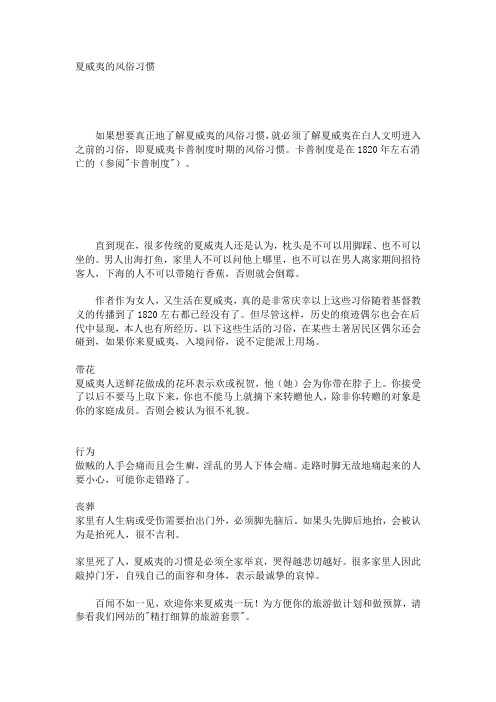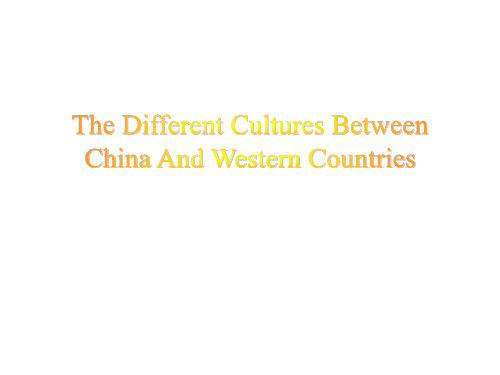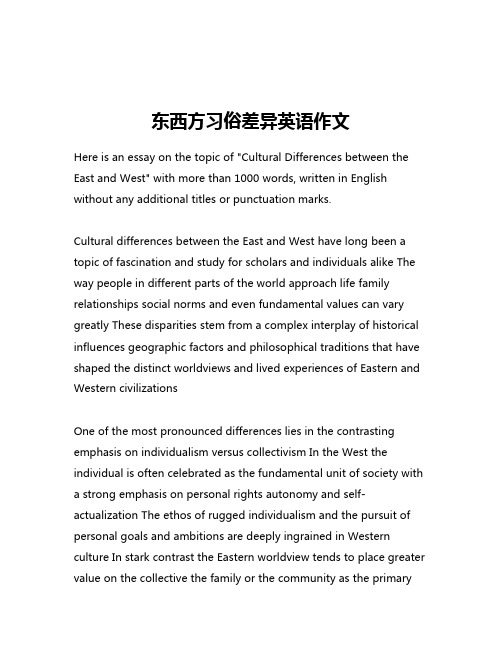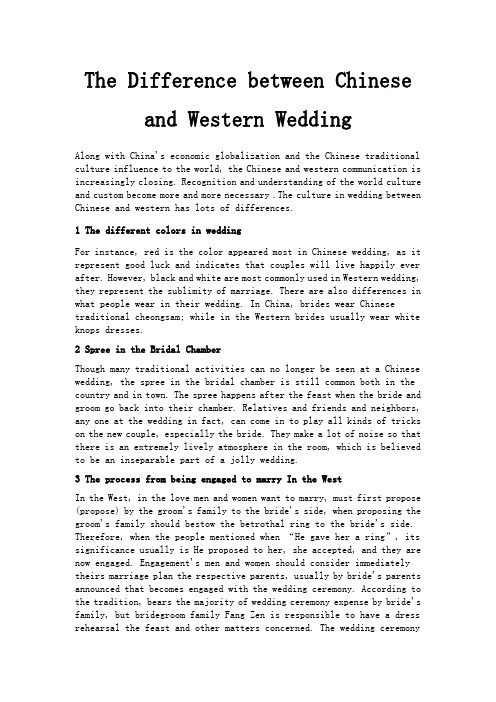中西方风俗习惯差异(英文版)共35页文档
风俗习惯(中西方差异)英语版汇总

夏威夷的风俗习惯如果想要真正地了解夏威夷的风俗习惯,就必须了解夏威夷在白人文明进入之前的习俗,即夏威夷卡普制度时期的风俗习惯。
卡普制度是在1820年左右消亡的(参阅"卡普制度")。
直到现在,很多传统的夏威夷人还是认为,枕头是不可以用脚踩、也不可以坐的。
男人出海打鱼,家里人不可以问他上哪里,也不可以在男人离家期间招待客人,下海的人不可以带随行香蕉,否则就会倒霉。
作者作为女人,又生活在夏威夷,真的是非常庆幸以上这些习俗随着基督教义的传播到了1820左右都已经没有了。
但尽管这样,历史的痕迹偶尔也会在后代中显现,本人也有所经历。
以下这些生活的习俗,在某些土著居民区偶尔还会碰到,如果你来夏威夷,入境问俗,说不定能派上用场。
带花夏威夷人送鲜花做成的花环表示欢或祝贺,他(她)会为你带在脖子上。
你接受了以后不要马上取下来,你也不能马上就摘下来转赠他人,除非你转赠的对象是你的家庭成员。
否则会被认为很不礼貌。
行为做贼的人手会痛而且会生癣,淫乱的男人下体会痛。
走路时脚无故地痛起来的人要小心,可能你走错路了。
丧葬家里有人生病或受伤需要抬出门外,必须脚先脑后。
如果头先脚后地抬,会被认为是抬死人,很不吉利。
家里死了人,夏威夷的习惯是必须全家举哀,哭得越悲切越好。
很多家里人因此敲掉门牙,自残自己的面容和身体,表示最诚挚的哀悼。
百闻不如一见,欢迎你来夏威夷一玩!为方便你的旅游做计划和做预算,请参看我们网站的"精打细算的旅游套票"。
对外交往中的西方礼节与风俗习惯文化主要是指人类所创造的物质财富和精神财富以及社会化行为的积淀,它包括信仰、艺术、道德、风俗、习惯等,是一个复杂的总体,具有鲜明的时代性、民族性和地域性。
生活在某一地区的每个成员,都会自觉或不自觉地受到该地区文化的熏陶和影响,对该地区的文化有着天然的认同感,并形成共同的文化心理特征。
在对外交流和交往过程中,了解作为西方文化重要组成部分的西方礼节与风俗习惯可以帮助我们跨越由于文化障碍所造成的鸿沟,成功而迅速地达到交际的目的。
东西方习俗差异英语作文

东西方习俗差异英语作文英文回答:Cultural Differences Between East and West.The East and West have a long and storied history of interaction, exchange, and conflict. This interaction has led to the development of a number of cultural differences between the two regions.One of the most striking differences between Eastern and Western cultures is the way they view individualism and collectivism. In Eastern cultures, the individual is seen as part of a larger group, such as the family, clan, or community. The interests of the group are seen as more important than the interests of the individual. In Western cultures, on the other hand, the individual is seen as more important than the group. Individuals are expected to be independent and self-sufficient.Another major difference between Eastern and Western cultures is the way they view time. In Eastern cultures, time is seen as cyclical. This means that events are seen as repeating themselves over and over again. In Western cultures, on the other hand, time is seen as linear. This means that events are seen as happening once and only once.The different views of time have a number of implications for the way that people in Eastern and Western cultures approach life. For example, people in Eastern cultures are more likely to be patient and to take a long-term view of things. People in Western cultures, on the other hand, are more likely to be impatient and to focus on the short term.The different views of time also have implications for the way that people in Eastern and Western cultures work. In Eastern cultures, people are more likely to work in groups and to emphasize cooperation. In Western cultures, on the other hand, people are more likely to work independently and to emphasize competition.The cultural differences between East and West are complex and multifaceted. However, by understanding these differences, we can better understand ourselves and our place in the world.中文回答:东西方文化差异。
中西方文化差异英文版

In China
throws the embroidered ball
• Bride and bridegroom • The date of birth and the eight
characters of a horoscope • Red clothes(the red color
Parting in English
• Western people always find some reasons for their leaving. Such as:
• “I am afraid I must be off, I have to …” • “Well, it’s been nice to see you again. I do enjoy our talk
Greeting in English
• People often employ the following expressions to greet each other :
• Good morning/evening/afternoon. • Fine day, isn’t it? • How is everything going?
Contents
1.Greeting and Parting 2.Marriage customs 3.Eating customs
Байду номын сангаас
Greeting in China
• When people meet acquaintances or friends, we always say :
• Have you eaten yet? • What are you going to do?
东西方习俗差异英语作文

东西方习俗差异英语作文Here is an essay on the topic of "Cultural Differences between the East and West" with more than 1000 words, written in English without any additional titles or punctuation marks.Cultural differences between the East and West have long been a topic of fascination and study for scholars and individuals alike The way people in different parts of the world approach life family relationships social norms and even fundamental values can vary greatly These disparities stem from a complex interplay of historical influences geographic factors and philosophical traditions that have shaped the distinct worldviews and lived experiences of Eastern and Western civilizationsOne of the most pronounced differences lies in the contrasting emphasis on individualism versus collectivism In the West the individual is often celebrated as the fundamental unit of society with a strong emphasis on personal rights autonomy and self-actualization The ethos of rugged individualism and the pursuit of personal goals and ambitions are deeply ingrained in Western culture In stark contrast the Eastern worldview tends to place greater value on the collective the family or the community as the primarylocus of identity and loyalty Individual desires and needs are often subordinate to the harmony and well-being of the group This collectivist orientation is reflected in various social norms and practices such as the importance of filial piety in Confucian societies deference to authority hierarchical decision-making structures and a strong sense of in-group loyaltyAnother key difference manifests in the realm of interpersonal relationships and communication styles Whereas Western cultures tend to emphasize direct verbal expression of thoughts and feelings Eastern cultures often prioritize more nuanced and indirect modes of communication Maintaining harmony and saving face are paramount concerns in many Eastern societies leading to a greater reliance on nonverbal cues body language and implicit understandings rather than explicit verbal articulation This can result in misunderstandings and frustrations when Westerners interact with their Eastern counterparts who may perceive direct questioning or confrontational styles as rude or inappropriateThe contrasting attitudes toward time and temporal orientation also distinguish Eastern and Western worldviews In the West there is often a linear perception of time with a strong focus on punctuality productivity and the efficient use of time The future is seen as a horizon of possibilities to be actively pursued and conquered Conversely many Eastern cultures embrace a more cyclical andorganic view of time where the present moment is cherished and the future is approached with a greater sense of patience and acceptance This temporal orientation is reflected in various cultural practices such as the emphasis on slow deliberate rituals in Eastern spiritual traditions the importance of maintaining harmonious relationships over short-term gains and a general aversion to overt displays of ambition or competitivenessThe realms of spirituality and religiosity also reveal significant divergences between the East and West While the Abrahamic faiths of Judaism Christianity and Islam have dominated the Western religious landscape Eastern traditions such as Hinduism Buddhism and Taoism have shaped profoundly different worldviews and approaches to the divine the self and the nature of existence These Eastern belief systems often emphasize the interconnectedness of all things the impermanence of the material world and the pursuit of enlightenment or harmonious integration with the cosmos rather than the notion of an omnipotent deity and the struggle between good and evil that characterizes much of Western theologyCulinary traditions represent another arena where Eastern and Western cultures exhibit stark contrasts The cuisines of the East tend to emphasize balance harmony and the synergistic interplay of flavors ingredients and cooking methods Dishes are often designed to reflect the principles of yin and yang with a careful balance ofcomplementary tastes and textures In contrast Western cuisine particularly in the modern era has often been characterized by a more individualistic approach where the chef's personal creativity and the diner's preferences take precedence over traditional conventions of balance and harmony This is reflected in the emphasis on bold flavors single-ingredient dishes and the widespread adoption of fusion cuisines that blend disparate culinary traditionsBeyond these broad generalizations it is important to recognize that both the East and the West are vast and diverse regions encompassing a multitude of cultures ethnicities and traditions that defy simplistic categorization Moreover the lines between Eastern and Western worldviews have become increasingly blurred in the age of globalization as cross-cultural exchange and the diffusion of ideas have led to the hybridization of cultural practices and the erosion of rigid boundaries Nevertheless an understanding of these deep-seated differences can provide valuable insights into the rich tapestry of human civilization and foster greater empathy and appreciation for the diverse ways in which people make meaning of their lived experiences across the globe。
中西方传统节日文化差异英语PPT

eating and drinking the seeking of pleasure and entertainments
The difference of festival diet characteristics
• ( Chinese)traditional festival diet tends
to be emotional, pay attention to color, flavor, smell and taste. Particularly festive food, each festival has to distinguish between different food of other festivals.
• The festivals in( China)mainly stem
from seasons and solar terms, which are
closely related to agriculture.
• The festivals in(Western
)
generally stem fcroomurneltigriioensand its
• When celebrating the festivals, the
( Chinese)tend to focus more attention
on eating and drinking.
• When celebrating the) tend to put more asttention to the seeking of pleasure and
• While in the (Wes ) , white symbolic significance foctus on their own colors, such
中西方节日文化差异比较中英文版

OECD says Unemployment Will Continue to RiseOECD:工业化国家失业率持续攀升Despite reports that many industrialized economies are beginning toemerge from their worst economic crisis in decades, unemployment is rising and will likely reach a historic peak of nearly 10 percent next year. The findings come from the Organization for Economic Cooperation and Development in Paris.经济合作与发展组织星期三报告说,工业化国家的失业率仍在增加,而且有可能在明年达到近10%的历史最高水平,尽管不断有报道说,很多工业化国家正在走出几十年来最严重的经济危机。
Indications that unemployment continues to rise is grim news for leaders heading to the G-20 summit in the United States next week. The Paris-based Organization for Economic Cooperation and Development reports unemployment reached its highest level among industrialized nations of 8.5 percent in July.对于下个星期到美国出席20国集团峰会的各国领导人来说,失业率继续上升真是个坏消息。
总部设在巴黎的经合组织说,工业化国家的失业率已经在今年7月份达到8.5%的最高水平。
中西方礼仪差异 英文

The difference of table manners
The definition of manners
Etiquette is not only the people exchange rules, but also a language,and is a kind of tools .
The cause of making difference
Different manners may result in cultural differences.
1. Cultural Background 2. Different values 3. Individualism and Collectivism 4. Family 5. Nationalism
批注本地保存成功开通会员云端永久保存去开通
The East-West differences in etiquette
Maker: Guo Wanyao Li Lidan
Content
The definition of manners
The cause of making difference
…
The difference of communication manners
1.Greeting and Parting
In China, When people meet acquaintances or friends, we always say ,“Have you eaten yet?” “What are you going to do?”
The tablewares of China are: chopsticks , bowl and spoon.
中西方婚礼的差异(英语篇)

The Difference between Chinese and Western WeddingAlong with China's economic globalization and the Chinese traditional culture influence to the world, the Chinese and western communication is increasingly closing. Recognition and understanding of the world culture and custom become more and more necessary .The culture in wedding between Chinese and western has lots of differences.1 The different colors in weddingFor instance, red is the color appeared most in Chinese wedding, as it represent good luck and indicates that couples will live happily ever after. However, black and white are most commonly used in Western wedding, they represent the sublimity of marriage. There are also differences in what people wear in their wedding. In China, brides wear Chinese traditional cheongsam; while in the Western brides usually wear white knops dresses.2 Spree in the Bridal ChamberThough many traditional activities can no longer be seen at a Chinese wedding, the spree in the bridal chamber is still common both in the country and in town. The spree happens after the feast when the bride and groom go back into their chamber. Relatives and friends and neighbors, any one at the wedding in fact, can come in to play all kinds of tricks on the new couple, especially the bride. They make a lot of noise so that there is an extremely lively atmosphere in the room, which is believed to be an inseparable part of a jolly wedding.3 The process from being engaged to marry In the WestIn the West, in the love men and women want to marry, must first propose (propose) by the groom's family to the bride's side, when proposing the groom's family should bestow the betrothal ring to the bride's side. Therefore, when the people mentioned when “He gave her a ring”, its significance usually is He proposed to her, she accepted, and they are now engaged. Engagement's men and women should consider immediately theirs marriage plan the respective parents, usually by bride's parents announced that becomes engaged with the wedding ceremony. According to the tradition, bears the majority of wedding ceremony expense by bride's family, but bridegroom family Fang Zen is responsible to have a dress rehearsal the feast and other matters concerned. The wedding ceremonystarts previous 1-2 days should officially to have a dress rehearsal, does the goal is causes to participate in wedding ceremony's each people to be familiar with them to want the routine procedure at the wedding ceremony.4 The wedding ceremony in the Western country is a very important situation,In the hold wedding ceremony first several weeks, the relatives and friends will receive the invitation letter. The wedding ceremony is moreover is held in the church in the daytime, if you attain the invitation, then when attends the wedding ceremony the clothing should be official. The female guest puts on the cocktail party formal clothes either the long shirt adds the holiday coat or the woolen sweater; the male guest wants to put on the formal clothes. It is noteworthy that woman puts on the pants is inappropriate, regardless of the pants are any color.5 the wedding flowerAt the westerner wedding ceremony flowers are funded at everywhere, from the church to the hotel, slightly to church in each chair, there is no place does not have the flower's existence. They like the use pink color department the flower, powdery white, the powder is blue, flesh color, the powder is green, and powder purple, light creamy yellow…Moreover they like using the fresh flowers, will not use the artificial flower. Generally marries every time to the new person, fresh flower's amount of use is quite big. Finds at everywhere is the flower, because of each splendid attire attendance woman, no matter its age, can put on a wad flower in the chignon place to show to new people's respect.6 Giving a presentGives a present is the custom which many nationalities altogether have, especially in china then time relatives and friends’ marriage what delivers ]ell We provide some principles for everybody reference: First is posse. Belly the goods which likes for the accepting gifts person, next do not be too expensive, has is again must have the usability.7 The custom of veil and kissWestern female when marriage also has wears veil's custom, at first, the bride wears the veil is young and the chastity symbol, but believes in Catholicism's bride to wear the veil to represent chastely. Therefore, many brides rush to the church holds when the wedding ceremony chooses wear the double-decked veil. After bride's father gives the daughter the bridegroom, by the bridegroom personally opened the veil. Finally, according to the custom, the wedding ceremony finished by new person's kiss announcement. This kisses the rich profound meaning: Through kissing,a person's breath and the partial souls keep another person in vivo, love cause them to combine. However in china people like to choose the red veil and kiss the lover at no others’ place.8 The main character of Chinese weddingChinese wedding ceremonies end with fireworksChinese weddings gather people for a banquet after the ceremony, usually on a restaurant. Western couples invite people to their home.The Chinese bride and groom are usually chosen by their parents; if they disobey their parents' wish, they can be social outcasts, lose their jobs and so on. Marriage in China is thus more of a social contract between families than a binding of love. This is one reason to why out of wedlock relations are so common in China. And it is also a reason to why Chinese girls look for foreigner. Note that children born out of wedlock have no rights in China; no right to go to school, no right to medical care and so on; this is what the 5000 year old culture so proudly call human interestIn shortCultural traditions range from dress to participation. In some cases a groom takes the lead and in others the bride takes the leading role. Wedding ceremonies differ greatly - not just between China and the Western countries - but they differ widely even among the people themselves in any country you choose to look at. Through the study of differences between Chinese and western at the wedding of the cultural I have opened horizon and Learned lots of knowledge.。
- 1、下载文档前请自行甄别文档内容的完整性,平台不提供额外的编辑、内容补充、找答案等附加服务。
- 2、"仅部分预览"的文档,不可在线预览部分如存在完整性等问题,可反馈申请退款(可完整预览的文档不适用该条件!)。
- 3、如文档侵犯您的权益,请联系客服反馈,我们会尽快为您处理(人工客服工作时间:9:00-18:30)。
Refers to traditional fashion, etiquette habits of individuals or collectives .Is a specific social and cultural areas people abide by patterns of behavior or specifications at all times. Mainly includes the national customs, traditional festival custom, etiquette and so on. Custom formed by history. It Strongly restricts the behavior of social members .Customs is the basis of social morality and law
Then, Bunni Creole town residents and tens of thousands of volunteers all able to take advantage of the water tap is opened entirely, to invest in another battle - sweep the streets. About an hour later, the square and the streets were swept clean again, Bunni Creole town resumed usual quiet.
This time of year, tourists from around the world gathered in Bunol town,Here, tomatoes does not only bring the joy of harvest, as well as carnival fun.
1 two kind of different diet idea
Chinese: Flavor Western: Rational diet idea
2 China and west diet object’s difference
China: corn, noodles,vegetables,some meat West: meat,milk
严晴 12142112
Tomato Festival is the Spanish famous traditional festivals!Began in 1945, the last Wednesday of August which held once a year. According to legend, one day, the city from a small band of downtown blowing horns swagger through the streets, led by Alice who is the speaker to the sky. At this time, a group of young people a whim, grabbed the microphone tomatoes to throw, and the mutual competition, have a look who can put tomatoes thrown into. This is the "Tomato Fight".
Five areas about difference
1、Two kind of different diet idea 2、China and west diet object’s difference 3、Diet way’s different 4、Table etiquette difference and reflection of cultural difference
table etiquette difference
the arrangement of seats
reflection of cultural difference
classification
china: harmonious unified
Western customs ——European Festivals
12 noon the same day, with the order, the long wait for the people in the people's Square and nearby streets, immediately rushed to the 6 trucks loaded with tomatoes, grabbed the "red bullet" wild familiar or unfamiliar to the side people hit on the body. An hour later, the fighters were "run out of ammunition and food supplies, spend oneself", "tomato war" ended.
Dietary Cultures Festivals
Social customs
On differences between Chinese and western dietary cultures
12070215田原
Introduction
Geographical features Climate environment Customs
Diet ways
Chinese put into practice Gather Dining System(集体共享制). The west put into practice individual Dining System(个人
